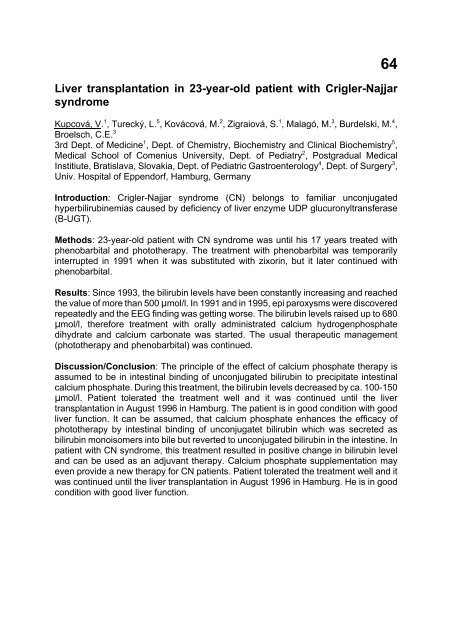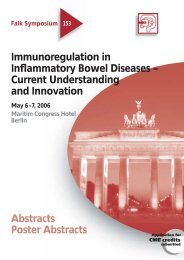Abstracts Poster Abstracts - Dr Falk
Abstracts Poster Abstracts - Dr Falk
Abstracts Poster Abstracts - Dr Falk
You also want an ePaper? Increase the reach of your titles
YUMPU automatically turns print PDFs into web optimized ePapers that Google loves.
64Liver transplantation in 23-year-old patient with Crigler-NajjarsyndromeKupcová, V. 1 , Turecký, L. 5 , Kovácová, M. 2 , Zigraiová, S. 1 , Malagó, M. 3 , Burdelski, M. 4 ,Broelsch, C.E. 33rd Dept. of Medicine 1 , Dept. of Chemistry, Biochemistry and Clinical Biochemistry 5 ,Medical School of Comenius University, Dept. of Pediatry 2 , Postgradual MedicalInstitiute, Bratislava, Slovakia, Dept. of Pediatric Gastroenterology 4 , Dept. of Surgery 3 ,Univ. Hospital of Eppendorf, Hamburg, GermanyIntroduction: Crigler-Najjar syndrome (CN) belongs to familiar unconjugatedhyperbilirubinemias caused by deficiency of liver enzyme UDP glucuronyltransferase(B-UGT).Methods: 23-year-old patient with CN syndrome was until his 17 years treated withphenobarbital and phototherapy. The treatment with phenobarbital was temporarilyinterrupted in 1991 when it was substituted with zixorin, but it later continued withphenobarbital.Results: Since 1993, the bilirubin levels have been constantly increasing and reachedthe value of more than 500 :mol/l. In 1991 and in 1995, epi paroxysms were discoveredrepeatedly and the EEG finding was getting worse. The bilirubin levels raised up to 680:mol/l, therefore treatment with orally administrated calcium hydrogenphosphatedihydrate and calcium carbonate was started. The usual therapeutic management(phototherapy and phenobarbital) was continued.Discussion/Conclusion: The principle of the effect of calcium phosphate therapy isassumed to be in intestinal binding of unconjugated bilirubin to precipitate intestinalcalcium phosphate. During this treatment, the bilirubin levels decreased by ca. 100-150:mol/l. Patient tolerated the treatment well and it was continued until the livertransplantation in August 1996 in Hamburg. The patient is in good condition with goodliver function. It can be assumed, that calcium phosphate enhances the efficacy ofphototherapy by intestinal binding of unconjugatet bilirubin which was secreted asbilirubin monoisomers into bile but reverted to unconjugated bilirubin in the intestine. Inpatient with CN syndrome, this treatment resulted in positive change in bilirubin leveland can be used as an adjuvant therapy. Calcium phosphate supplementation mayeven provide a new therapy for CN patients. Patient tolerated the treatment well and itwas continued until the liver transplantation in August 1996 in Hamburg. He is in goodcondition with good liver function.



